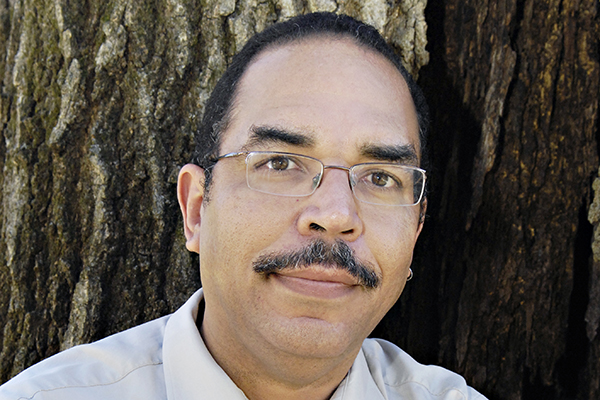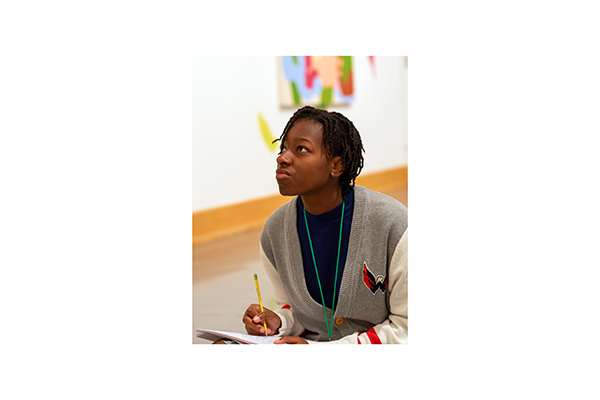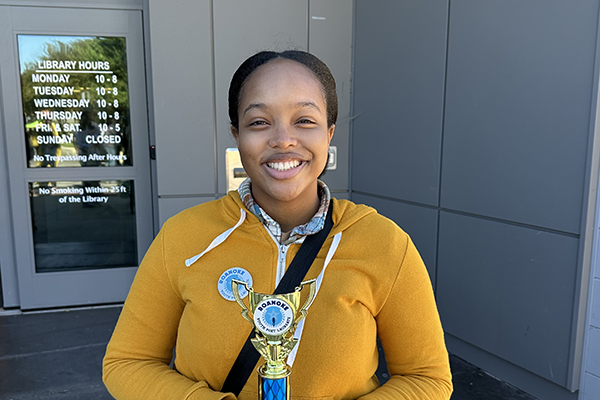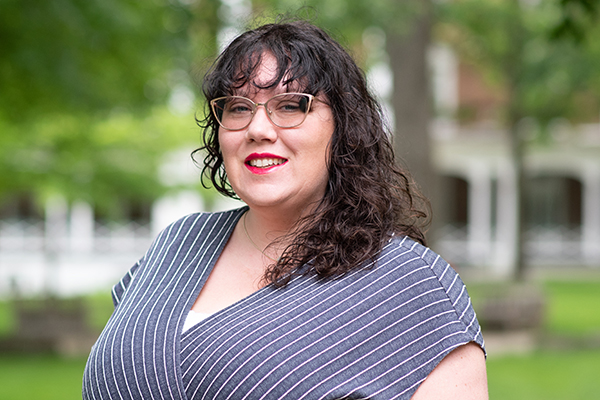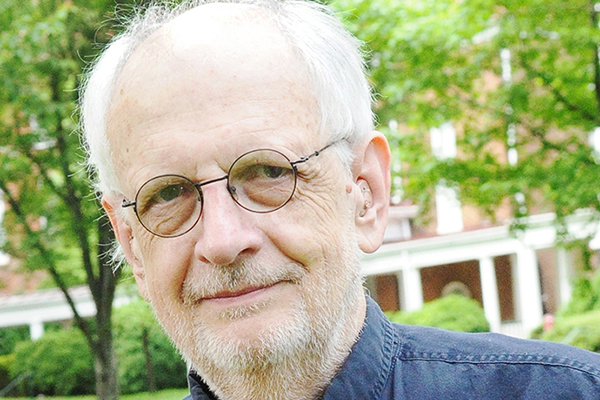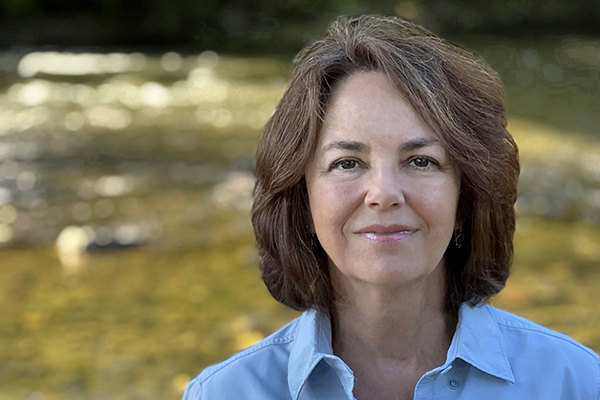When Professor of English and Creative Writing T.J. Anderson III is asked how long he spent writing his newest book, he says he always answers, “It took me 62 years.”
Of course, he’s joking. But as Anderson further explains, a profound truth lies in that reply. “First, I had to acquire language. I next had to acquire an aural sensibility because music is very much a part of my aesthetic. Then of course, I had to read a lot of books and a lot of poetry to get to this point.”
The latest literary stop on what Anderson describes as his life’s “artistic journey, a journey that is rooted in African-American culture and American culture” is Devonte Travels the Sorry Route, a collection of poems published in 2019 by Omnidawn Publishing. The work is his fourth volume of poetry following Cairo Workbook (Willow Books, 2014), River to Cross (The Backwaters Press, 2009), and the chapbook At Last Round Up (lift books, 1996). He is also the author of Notes to Make the Sound Come Right: Four Innovators of Jazz Poetry (University of Arkansas Press, 2004) and the spoken word CD, Blood Octave (Flat Five Recordings, 2006).
“I think the work that I write is me, and it’s also not me and it’s community,” Anderson said. “One of the things that I think is true, which is a way of thinking about the afterlife of slavery in regard to how we inhabit this historical time, is the sense of temporal engagement where the past, the present, and the future are not discreet and cut off from one another. Rather, we live in simultaneity of that entanglement. That’s my challenge as a writer: How does one narrate that? How do I bring those voices into dialogue?”
When describing his aesthetic, Anderson cites two core components. He employs fragmentation and compares it to making “a quilt where I’m constantly gathering various kinds of materials, different kinds of fabrics, some silk, some rough cotton, and stitching these things together so that these fragments are in conversation. There’s the use of space in my work, too, where there are things that can’t be said or I haven’t found the words for these things.”
Devonte Travels the Sorry Route is presented in four parts, and Anderson has also developed a process for making those divisions that aligns with his perception of the poem as a musical score. “I’ll print out all of my poems and go into a large room and lay every piece of paper on the floor. Then, I’ll walk around and read them. I’ll see what fits, what’s developing in terms of a narrative and musicality. First and foremost, it’s music. I’m orchestrating things in terms of how I hear them sounding and putting them into a particular order. They’re kind of musical sections.”
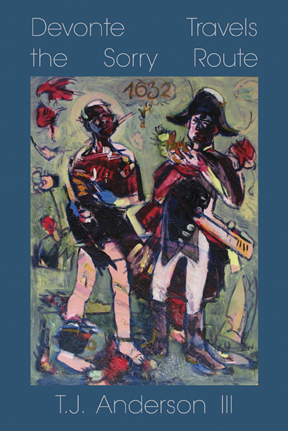
Anderson’s inspiration to begin writing the poems that would ultimately become Devonte Travels the Sorry Route stemmed from seeing a painting by Irish-American artist Brian Counihan called “The Sorry Route.” He was intrigued by the work’s two dominant figures – one man in a tri-cornered hat and another who appeared to be in shackles – and the way the painting evoked colonialism.
“All of a sudden I started writing these poems that came to me that embodied this voice of a character who called himself ‘Dickerson,’” Anderson recalled. “After I drafted a few of my Dickerson poems, I started sending them out to magazines and some were getting accepted, which was really pleasing. I began to see that somehow I was working on a series.”
Anderson learned that Omnidawn, which specializes in innovative and experimental writing and is one of the author’s favorite publishers, was sponsoring an Open Book Poetry Contest where anyone who has already published a book can submit an entry. He put the series of poems into a manuscript, changed the main character’s name from “Dickerson” to “Devonte,” and Devonte Travels the Sorry Route was created. To Anderson’s surprise, the manuscript was named a contest finalist.
“The publisher called to congratulate me and as I talked to him I realized that I had only 20 poems of mid-size length in the series. Now, that will get you what is called a chapbook, usually a small printing of poems that runs about 40 to 50 pages and has just a limited dissemination. So, I really tried to expand it by writing more poems and opening up more space.”
Why did Anderson change the name of his poems’ key figure? “‘Dickerson’ has a kind of harshness to it, so one point I was going to call the character ‘Dante’ as an allusion to The Inferno, but I decided not to do that. I chose ‘Devonte’ because it alluded to ‘Dante’ but it also was a distinctly African-American name and certainly sounded more poetic than ‘Dickerson.’ At the same time, I realized there was a young man by that name who was a victim of police violence.”
In the series, Anderson says his title character “traverses time. His sense of identity is constantly being cut by historical events, so much so that there becomes no discernable separation of past and present. I’m responding to the painting and shifts of identity within the African-American cultural and historical narrative. Devonte inhabits multiple dimensions, and in several poems, he encounters history on both a macro and micro level that doesn’t solely apply to dates and images. How do we deal with the ghost of history? Devonte resists and straddles all those attempts of containment by society.”
At its core, Devonte Travels the Sorry Route is the story of an artist for whom jazz is a profound force. “It is a spiritual connection that goes beyond consumptive entertainment and appreciation,” Anderson explained. “The idea of music – tonal sounds, tonal vibrations – and what it does to the body, and how it can affect one’s ability to be in multiple places at multiple times, that’s of interest to me.”
The book’s second pivotal character, “more of an idea than an actual person,” is “Isabella.” “I see her as a representation of colonialism and its exploitation of the land that some people see as feminine. But Isabella is being used. She becomes a participant in White supremacist domination. It’s a gendered idea that’s problematic and I hope readers see that.”
Still, Anderson is comfortable with readers approaching his work differently from his own interpretation of it and even missing the allusions he makes. He recalls his own study years ago of the influential American poet Charles Olson and his seminal work Maximus Poems, a long serial poem that encompasses more than one thousand pages. “I read that entire book, I also read the criticism, I also read the biographies on him, and I didn’t understand everything. But later on, the more you allow things to ruminate and to simmer, I began to gain more of an understanding of his work. I think that’s the way I’ve always approached literature and particularly difficult literature. I don’t necessarily feel the need to ‘get’ something at first reading, that it’s important to go back and sit with something, and maybe 20 years from now you might say, ‘Oh, that’s what that line meant. Okay, I get it now.’ And that’s fine. The process for me, the process of literature, is an organic process.”
Watch Anderson’s presentation, Devonte Travels the Sorry Route: The Making of a Manuscript, part of the Faculty Authors and Achievers series sponsored by the Wyndham Robertson Library.



